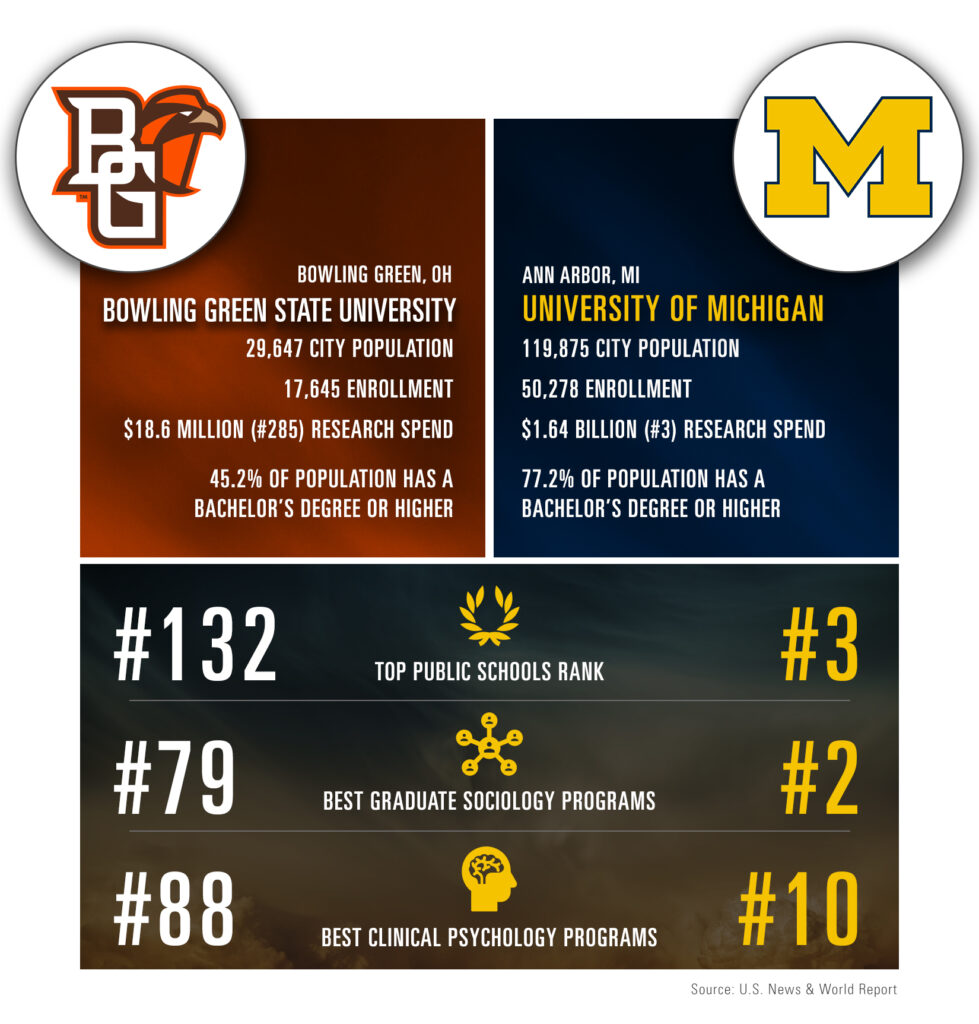
Game 3: Saturday, September 16, 2023 | Michigan vs. BGSU | Michigan Stadium | 7:30pm EST
Ann Arbor SPARK’s popular football blog series is back for Michigan’s 144th season! We use the football season as an opportunity to compare Ann Arbor to cities around the country represented by our U-M football competition. The question is always – how does Ann Arbor compare to other college towns in the U.S.?
Week three brings with it the last of the non-conference games for Michigan and the third matchup in history between the Wolverines and the Falcons. The Wolverines enter the week 2-0 and the Falcons sit at 1-1. Michigan is favored to win.
Bowling Green, Ohio, situated in Wood County, is best known as the home of Bowling Green State University (BGSU), which serves as a significant economic driver for the region. Bowling Green is close to Toledo, Ohio and is only about 70 miles south of Ann Arbor via US-23. Situated in a primarily rural area, agriculture has always been an essential part of Bowling Green’s economic framework. Farms in and around the city produce a variety of crops and livestock, providing local and regional markets with fresh products. Bowling Green was an early adopter of wind energy in Ohio. The Bowling Green Wind Farm, which started operation in the early 2000s, marked the state’s first utility-scale wind farm. This move has paved the way for the city to embrace other renewable energy initiatives, positioning it as a progressive community in terms of sustainability.
With a population of only 29,647, Bowling Green is about a quarter of the size of Ann Arbor and BGSU’s student enrollment is the equivalent to 35 percent of U-M’s.

As a smaller community, Bowling Green enjoys a slightly lower unemployment rate than Ann Arbor (3.2 percent and 4.0 percent, respectively). The labor force participation rate in Ann Arbor is higher than in Bowling Green (66.8 percent in Ann Arbor and 63.8 percent in Bowling Green). Not surprisingly, the overall cost of living in Bowling Green is lower when compared to Ann Arbor (cost of living index of 94.3 vs 99.9) and the median household income in Bowling Green is about half the median household income in Ann Arbor ($37,356 vs $73,276). In Bowling Green, only 45.2 percent of the population over the age of 25 possess a bachelor’s degree or higher.
Be on the lookout for our blog posts ahead of each game all season long and be sure to tag us when you share these interesting tidbits with your friends via social media! And, if you want more information like this or are curious to learn more about the Ann Arbor region and what makes it such a great place to live, work, and locate your business, please reach out to our Director of Research, Melissa Sheldon.
In case you missed it, here are links to the regional comparisons we’ve posted so far this year:
Benchmarking the Ann Arbor Region: 2023 Economic Competitive Assessment
Week 1: Ann Arbor vs. Greenville, NC
Week 2: Ann Arbor vs. Las Vegas, NV